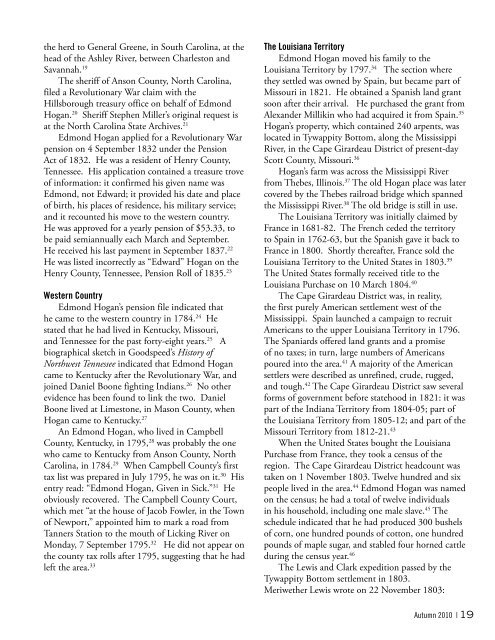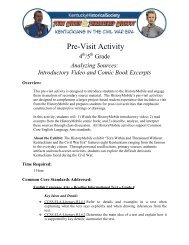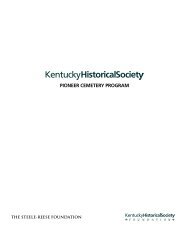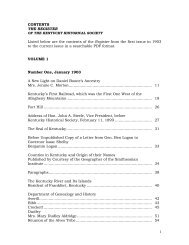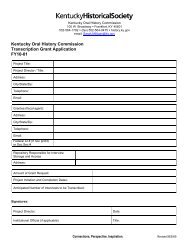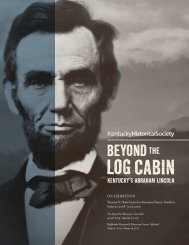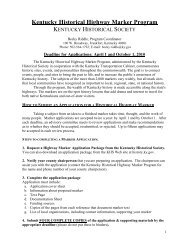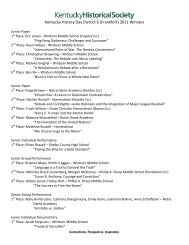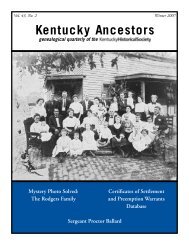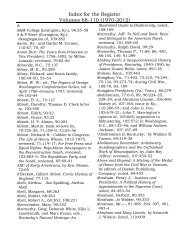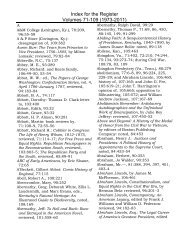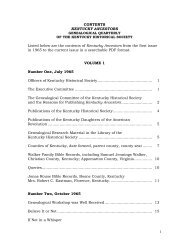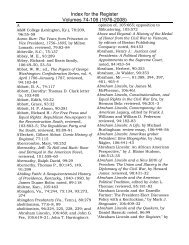Kentucky Ancestors, Volume 46, Number 1 - Kentucky Historical ...
Kentucky Ancestors, Volume 46, Number 1 - Kentucky Historical ...
Kentucky Ancestors, Volume 46, Number 1 - Kentucky Historical ...
Create successful ePaper yourself
Turn your PDF publications into a flip-book with our unique Google optimized e-Paper software.
the herd to General Greene, in South Carolina, at the<br />
head of the Ashley River, between Charleston and<br />
Savannah. 19<br />
The sheriff of Anson County, North Carolina,<br />
filed a Revolutionary War claim with the<br />
Hillsborough treasury office on behalf of Edmond<br />
Hogan. 20 Sheriff Stephen Miller’s original request is<br />
at the North Carolina State Archives. 21<br />
Edmond Hogan applied for a Revolutionary War<br />
pension on 4 September 1832 under the Pension<br />
Act of 1832. He was a resident of Henry County,<br />
Tennessee. His application contained a treasure trove<br />
of information: it confirmed his given name was<br />
Edmond, not Edward; it provided his date and place<br />
of birth, his places of residence, his military service;<br />
and it recounted his move to the western country.<br />
He was approved for a yearly pension of $53.33, to<br />
be paid semiannually each March and September.<br />
He received his last payment in September 1837. 22<br />
He was listed incorrectly as “Edward” Hogan on the<br />
Henry County, Tennessee, Pension Roll of 1835. 23<br />
Western Country<br />
Edmond Hogan’s pension file indicated that<br />
he came to the western country in 1784. 24 He<br />
stated that he had lived in <strong>Kentucky</strong>, Missouri,<br />
and Tennessee for the past forty-eight years. 25 A<br />
biographical sketch in Goodspeed’s History of<br />
Northwest Tennessee indicated that Edmond Hogan<br />
came to <strong>Kentucky</strong> after the Revolutionary War, and<br />
joined Daniel Boone fighting Indians. 26 No other<br />
evidence has been found to link the two. Daniel<br />
Boone lived at Limestone, in Mason County, when<br />
Hogan came to <strong>Kentucky</strong>. 27<br />
An Edmond Hogan, who lived in Campbell<br />
County, <strong>Kentucky</strong>, in 1795, 28 was probably the one<br />
who came to <strong>Kentucky</strong> from Anson County, North<br />
Carolina, in 1784. 29 When Campbell County’s first<br />
tax list was prepared in July 1795, he was on it. 30 His<br />
entry read: “Edmond Hogan, Given in Sick.” 31 He<br />
obviously recovered. The Campbell County Court,<br />
which met “at the house of Jacob Fowler, in the Town<br />
of Newport,” appointed him to mark a road from<br />
Tanners Station to the mouth of Licking River on<br />
Monday, 7 September 1795. 32 He did not appear on<br />
the county tax rolls after 1795, suggesting that he had<br />
left the area. 33<br />
The Louisiana Territory<br />
Edmond Hogan moved his family to the<br />
Louisiana Territory by 1797. 34 The section where<br />
they settled was owned by Spain, but became part of<br />
Missouri in 1821. He obtained a Spanish land grant<br />
soon after their arrival. He purchased the grant from<br />
Alexander Millikin who had acquired it from Spain. 35<br />
Hogan’s property, which contained 240 arpents, was<br />
located in Tywappity Bottom, along the Mississippi<br />
River, in the Cape Girardeau District of present-day<br />
Scott County, Missouri. 36<br />
Hogan’s farm was across the Mississippi River<br />
from Thebes, Illinois. 37 The old Hogan place was later<br />
covered by the Thebes railroad bridge which spanned<br />
the Mississippi River. 38 The old bridge is still in use.<br />
The Louisiana Territory was initially claimed by<br />
France in 1681-82. The French ceded the territory<br />
to Spain in 1762-63, but the Spanish gave it back to<br />
France in 1800. Shortly thereafter, France sold the<br />
Louisiana Territory to the United States in 1803. 39<br />
The United States formally received title to the<br />
Louisiana Purchase on 10 March 1804. 40<br />
The Cape Girardeau District was, in reality,<br />
the first purely American settlement west of the<br />
Mississippi. Spain launched a campaign to recruit<br />
Americans to the upper Louisiana Territory in 1796.<br />
The Spaniards offered land grants and a promise<br />
of no taxes; in turn, large numbers of Americans<br />
poured into the area. 41 A majority of the American<br />
settlers were described as unrefined, crude, rugged,<br />
and tough. 42 The Cape Girardeau District saw several<br />
forms of government before statehood in 1821: it was<br />
part of the Indiana Territory from 1804-05; part of<br />
the Louisiana Territory from 1805-12; and part of the<br />
Missouri Territory from 1812-21. 43<br />
When the United States bought the Louisiana<br />
Purchase from France, they took a census of the<br />
region. The Cape Girardeau District headcount was<br />
taken on 1 November 1803. Twelve hundred and six<br />
people lived in the area. 44 Edmond Hogan was named<br />
on the census; he had a total of twelve individuals<br />
in his household, including one male slave. 45 The<br />
schedule indicated that he had produced 300 bushels<br />
of corn, one hundred pounds of cotton, one hundred<br />
pounds of maple sugar, and stabled four horned cattle<br />
during the census year. <strong>46</strong><br />
The Lewis and Clark expedition passed by the<br />
Tywappity Bottom settlement in 1803.<br />
Meriwether Lewis wrote on 22 November 1803:<br />
Autumn 2010 | 19


